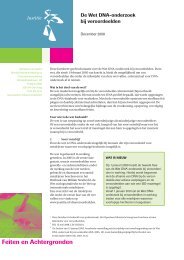eferences1 Retrieved from: www.iso.org/iso/iso_catalogue/catalogue_tc/catalogue_detail.htm?csnumber=398832 Retrieved from: www.fbi.gov/hq/lab/html/codis1.htm3 Retrieved from: www.enfsi.eu/index.php4Retrieved from: www.enfsi.eu/5 Retrieved from: www.fbi.gov/hq/lab/html/codis1.htm6 Retrieved from: www.unhchr.ch/udhr/lang/eng.htm7 Retrieved from: portal.unesco.org/en/ev.php-URL_ID=13177&URL_DO=DO_TOPIC&URL_SECTI<strong>ON</strong>=201.html8 Retrieved from: http://portal.unesco.org/en/ev.php-URL_ID=17720&URL_DO=DO_TOPIC&URL_SECTI<strong>ON</strong>=201.html9 Retrieved from: http://portal.unesco.org/en/ev.php-URL_ID=31058&URL_DO=DO_TOPIC&URL_SECTI<strong>ON</strong>=201.html10 The Innocence Project, Benjamin N. Cardozo School of Law at Yeshiva University, available at http://www.innocenceproject.org (accessed 1 June 2008).11 National Conference of State Legislatures, available at http://www.ncsl.org/programs/health/genetics/<strong>DNA</strong>chart.htm (accessed 1 June 2008).12 Saks, M. J., Constantine, L., Dolezal, M., Garcia, J., Titus, C., Horton, G., Leavell, T., Muntz, J., Rivera, L.,Stewart, J., Strumpf, F. and VanderHaar, H. (2001) Towards a model Act for the prevention and remedy oferroneous convictions. New England Law Review 35: 669-683.13Liebman, J. S., Fagan, J., West, V. and Lloyd, J. (2000) Capital attrition: error rates in capital cases, 1973-1995.Texas Law Review 78: 1839-1865.14The Queen v. Sean Hoey, In the Crown Court Sitting in Northern Ireland, Bill No: 341/05, 20 Dec. 2007.15 National Research Council, Committee on <strong>DNA</strong> Technology in Forensic Science,. (1992) <strong>DNA</strong>Technology in Forensic Science, 86-87.16 Bieber, F.R., Brenner, C.H., Lazer, D. (2006) Finding Criminals Through <strong>DNA</strong> of Their Relatives. Science,Vol.312, No 5778, 1315-1616. From <strong>DNA</strong> of Family, a Tool to Make Arrests, Ellen Nakashima, WashingtonPost, April 21, 2008.17 Dolan, M., Felch, J. (2008) State offers police extra <strong>DNA</strong> tool: California will use partial matches fromrelatives in its genetic database to try to track down criminals. Los Angeles Times, April 26, 2008.18 2008 Maryland Laws, Chapter 337, available at http://mlis.state.md.us/2008rs/chapters_noln/Ch_337_sb0211E.pdf.19 Greely, H.T., Riordan, D.P., Garrison, N.A., Mountain, J.L. (2006) Family Ties: The Use of <strong>DNA</strong> OffenderDatabases to Catch Offenders’ Kin. Journal of Law, Medicine & Ethics, Volume 34:2, 251-254.<strong>DNA</strong> Technology in Forensic Science, Committee on <strong>DNA</strong> Technology in Forensic Science, NationalResearch Council, 1992 (p. 86);20 Bieber, F.R., Brenner, C.H., Lazer, D. (2006) Finding Criminals Through <strong>DNA</strong> of Their Relatives. Science,Vol.312, No 5778, 1315-1616.21 Willing, R. (2006) <strong>DNA</strong> Database can flag suspects through relatives. USA Today.PAGE 110references
22 Greely, H.T., Riordan, D.P., Garrison, N.A., Mountain, J.L. (2006) Family Ties: The Use of <strong>DNA</strong> OffenderDatabases to Catch Offenders’ Kin. Journal of Law, Medicine & Ethics, Volume 34:2, 251-254.23 Williams, R., Johnson, P. (2006) Inclusiveness, Effectiveness and Intrusiveness: Issues in the DevelopingUses of <strong>DNA</strong> Profiling in Support of Criminal Investigations. Journal of Law, Medicine & Ethics, Vol. 34:2,242-245.24 Pericic, M., Lauc, L.B., Klaric, I.M., Janicijevic, B. & Rudan, P. (2005) Review of Croatian Genetic Heritage asrevealed by mitochondrial <strong>DNA</strong> and Y chromosomal lineages. Croatian Medical Journal 46(4): 502-513.25 Cann, R.L., Stoneking, M. and Wilson, A.C. (1987) Mitochondrial <strong>DNA</strong> and human evolution. Nature 325:31-36.26 Wilson, M.R., Polanskey, D., Butler, J.M., DiZinno, J.A., Replogle, J. and Budowle, B. (1995) Extraction, PCRamplification and sequencing of mitochondrial <strong>DNA</strong> from human hair shafts. BioTechniques 18: 662-66927Anderson, T.D., Ross, J.P., Roby, R.K., Lee, D.A. and Holland, M.M. (1999) A validation study for theextraction and analysis of <strong>DNA</strong> from human nail material and its application to forensic casework. Journalof Forensic Sciences 44: 1053-1056.28 Bender, K., Schneider, P.M. and Rittner, C. (2000) Application of mt<strong>DNA</strong> sequence analysis in forensiccasework for the identification of human remains. Forensic Science International 113: 103-107.29 Lorente, J.A., Entrala, C., Alvarez, J.C., Lorente, M., Arce, B., Heinrich, B., Carrasco, F., Budowle, B. andVillanueva, E. (2002) Social benefits on non-criminal genetic databases: missing persons and human remainsidentification. International Journal of Legal Medicine 116: 187-190.30Roby, R.K., Daoudi, Y., Dietz, S., McIntosh, T., Rogers, Y.-H., Reardon, M., Stockwell, T. and Adams, M.Automation of forensic mitochondrial <strong>DNA</strong> analysis in response to the attack on America. In Proceedingsof 16th International Australian and New Zealand Forensic Science Society Symposium on the ForensicSciences, Canberra, ACT, 13-17 May 2002.31 Holland, M.M., Cave, C.A., Holland, C.A. and Bille, T.W. (2003) Development of a quality, high throughput<strong>DNA</strong> analysis procedure for skeletal samples to assist with the identification of victims from the worldtrade centre attacks. Croatian Medical Journal 44: 264-272.32 Wilson, M.R. & Allard, M.W. (2004) Phylogenetic and mitochondrial <strong>DNA</strong>. Forensic Science Review 16: 37-62.33 Parson W, Dür A. (2007) EMPOP—A forensic mt<strong>DNA</strong> Database. Forensic Science International: Genetics1(2): 88-92. Retrieved from www.empop.org34 Parson W, Brandstätter A, Pircher M, Steinlechner M and Scheithauer R. (2004) EMPOP—the E<strong>DNA</strong>Pmt<strong>DNA</strong> population database concept for a new generation, high-quality mt<strong>DNA</strong> Database. InternationalCongress Series 1261: 106-108.35 Gill, P. (2001) An assessment of the utility of single nucleotide polymorphisms (SNPs) for forensicpurposes. International Journal of Legal Medicine 114: 204-210.36 Jobling, M.A., Pandya, A. and Tyler-Smith, C. (1997) The Y chromosome in forensic analysis and paternitytesting. International Journal of Legal Medicine 110: 118-124.37 Kayser, M., Caglia, A., et al. (1997) Evaluation of Y-chromosomal STRs: a multicenter study. InternationalJournal of Legal Medicine 110: 125-133.38 Dettlaff-Kakol, A. and Pawlowski, R. (2002) The first Polish <strong>DNA</strong> «manhumnt» - an application ofY-chromosome STR’s. International Journal of Legal Medicine 116: 289-291.39 Dziegelewski, M., Simich, J.P. and Rittenhouse-Olsen, K. (2002) Use of a Y chromosome probe as an aid inthe forensic proof of sexual assault. Journal of Forensic Sciences 47: 601 - 604.REFERENCES PAGE 111







